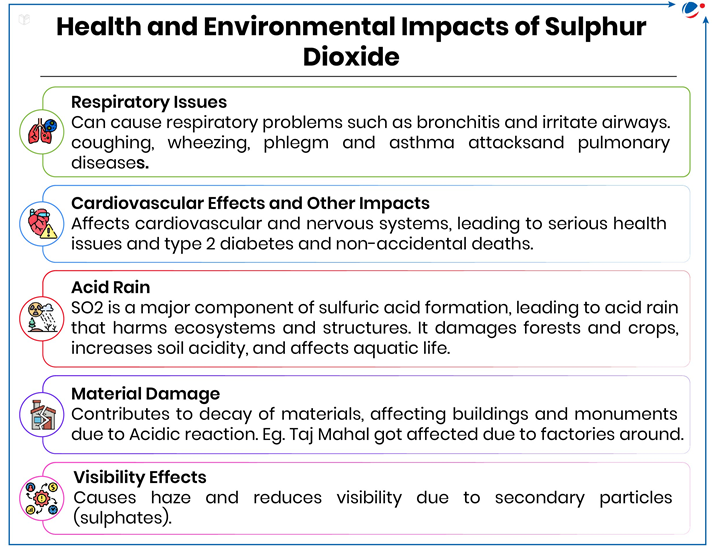Why in the News?
The Union Ministry of Environment, Forest and Climate Change (MoEF&CC) has issued fourth extension for thermal power plants (TPP) to comply with Sulphur dioxide (SO2) emission norms.
More about the News
- Extension from 2022 notification deadline: Ministry extended the deadlines for installing (FGD) systems in TPPs.
- As per 2022 notification deadlines for SO2 compliance for non-retiring TPPs were announced in September Category A by December 31, 2024; Category B by December 31, 2025 and Category C by December 31, 2026.
- New compliance deadline: Category A now has a deadline of December 31, 2027; Category B by December 31, 2028 and Category C by December 31, 2029 for installing Flue Gas Desulphurization (FGD) systems in TPPs.
- The flue gas desulfurization (FGD) plant removes sulfur dioxides (SO2) from flue gas produced by boilers, furnaces, and other sources.
- Category A included plants within a 10-kilometre radius of the NCR or cities with populations greater than one million.
- Category B included plants within a 10-kilometre radius of critically polluted areas or non-attainment cities and
- Category C includes all remaining plants.

- Genesis: In 2015, the MoEF&CC implemented India's first emission norms for SO2, NOₓ and mercury control, acknowledging the significant impact of coal-fired power plants on pollution levels
- 2017: The Union Ministry of Power requested an extension of seven years. The Supreme Court eventually granted five additional years, until 2022.
Sources of theSulphur dioxide
- Natural: Volcanoes (67%).
- Anthropogenic: Combustion of fossil fuel (coal, heavy fuel oil in thermal power plants, office, factories); Paper Industry; Extraction & distribution of fossil fuels; Smelting of metals (sulfide ores to produce copper, lead and zinc); Petroleum refining; Combustion process in diesel, petrol, natural gas driven vehicles etc.
Government regulations to control Sulphur dioxide
- The Air (Prevention and Control of Pollution) Act, 1981: This act empowers the Central Pollution Control Board (CPCB) and State Pollution Control Boards (SPCBs) to monitor and regulate the emission of pollutants, including SO2.
- Environment (Protection) Act, 1986: The government can set specific SO2 emission limits for industries like power plants, refineries, and cement manufacturing under the Environment Protection Act (EPA).
- National Ambient Air Quality Standards (NAAQS): The MoEFCC has established National Ambient Air Quality Standards to control the concentration of various pollutants, including sulfur dioxide.
- BS-VI Fuel Standards: The Indian government has implemented stricter Bharat Stage VI (BS-VI) emission standards for vehicles, which also regulate the sulfur content in fuels.
- National Clean Air Programme (NCAP), 2019 was launched by Ministry of Environment, Forest and Climate Change to control pollution.
- SAMEER App and Social Media Accounts (Facebook & Twitter) have been set up by CPCB, which have been very effective in monitoring performance of implementing agencies to curb Air Pollution.
Way forward
- Need of strict implementation of regulations: There should not be further extension of deadlines for installing (FGD) systems in TPPs.
- Fuel Cleaning: Employ fuel cleaning methods like coal beneficiation to remove pyritic sulfur before combustion. Coal washing can remove approximately 50% of pyritic sulfur and 20-30% of total sulfur.
- Shift to clean energy sources: Such as renewable energy sources and fuels like hydrogen through policies like National Green Hydrogen Mission.



